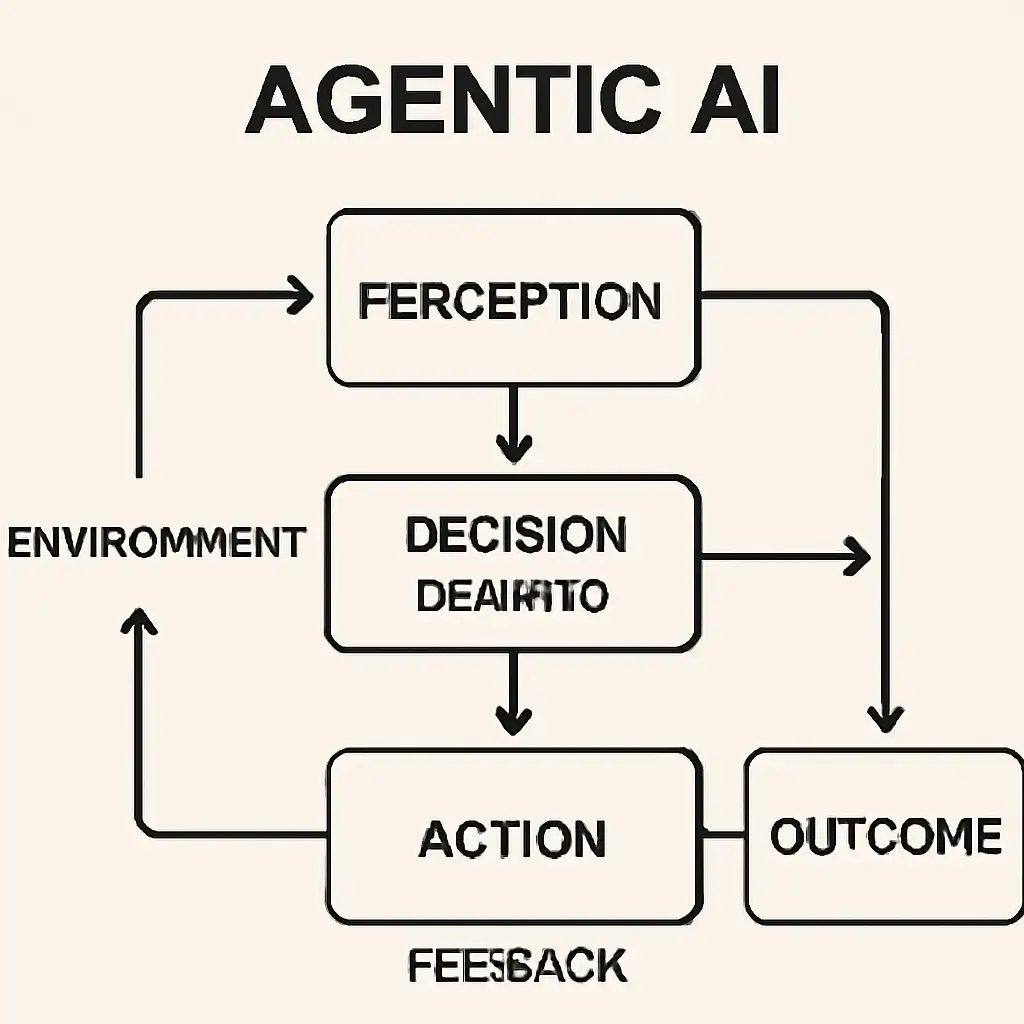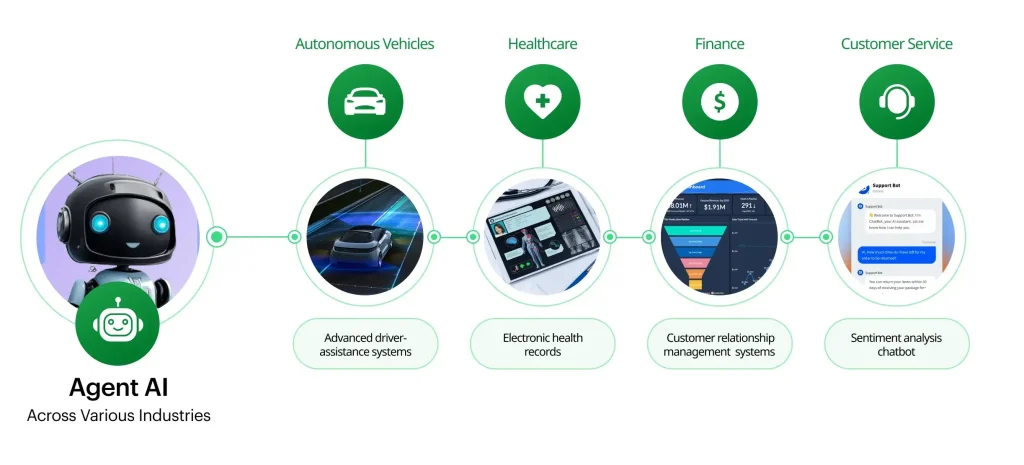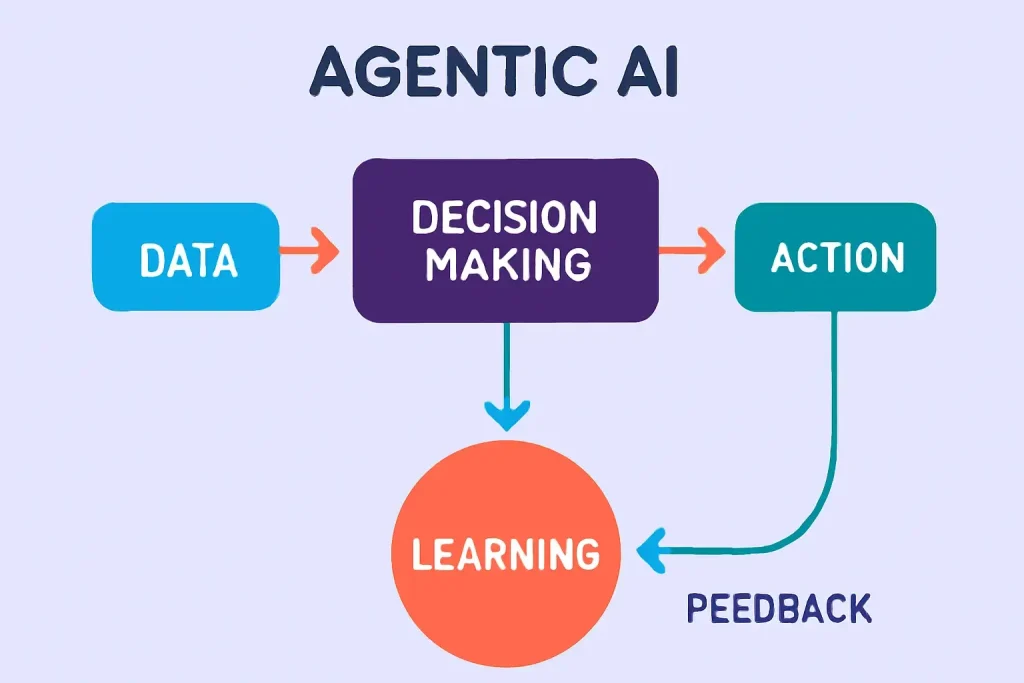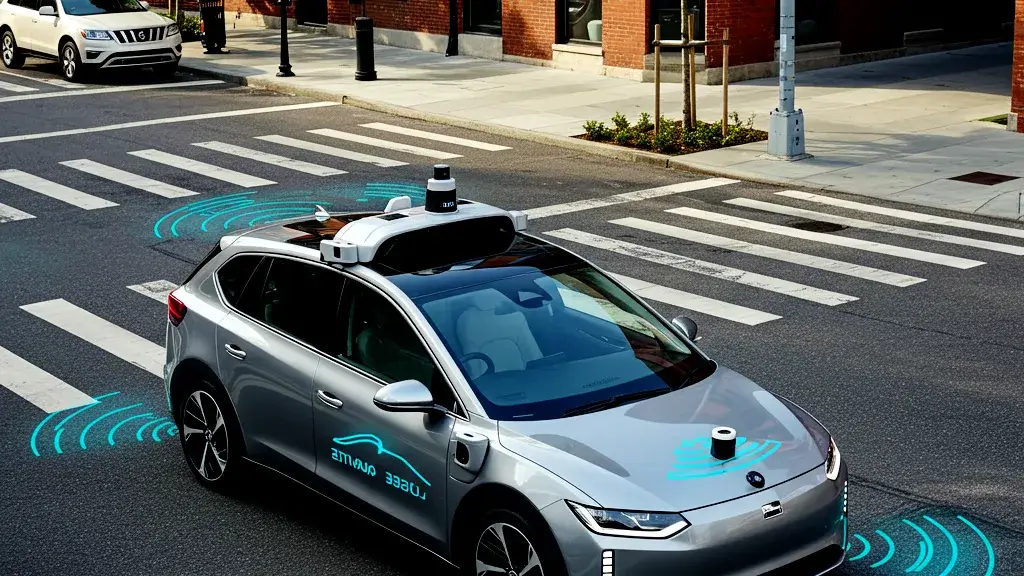1. Introduction
Explanation of Agentic AI
Agentic AI refers to a category of artificial intelligence systems capable of making decisions, taking actions, and solving problems autonomously without human intervention. Unlike traditional AI, which typically requires human oversight or input for task execution, Agentic AI operates independently, learning from data in real time and adapting to new circumstances. These systems are powered by advanced machine learning techniques, particularly reinforcement learning, which enables them to continuously improve their decision-making abilities based on experience.
At the core of Agentic AI is its ability to not only analyze large amounts of data but to also act on that data in ways that would traditionally require human judgment. This capability is made possible through advanced algorithms and data processing tools that allow the system to assess situations, predict outcomes, and execute actions autonomously. This makes Agentic AI incredibly powerful for tasks that demand constant monitoring and quick decision-making.

Importance in the Modern Technological Landscape
Agentic AI has gained significant attention in recent years due to its transformative potential across various industries. The increasing need for automation, optimization, and real-time decision-making has made Agentic AI a critical technology for businesses looking to remain competitive in a fast-paced digital world.
In industries such as healthcare, transportation, finance, and manufacturing, Agentic AI has the potential to streamline operations, reduce costs, and improve efficiency. For example, in healthcare, Agentic AI can assist doctors in diagnosing diseases or even suggesting treatment plans by analyzing patient data in real-time. In the transportation sector, it powers autonomous vehicles, enhancing safety and reducing human error. Furthermore, in finance, Agentic AI can predict market trends and optimize trading strategies with minimal human intervention.
The rise of Agentic AI also sparks discussions about the ethical implications of autonomous decision-making. As AI systems take on more complex and sensitive roles, questions surrounding accountability, fairness, and privacy become increasingly important. Despite these concerns, the benefits of Agentic AI, such as enhanced productivity and cost savings, continue to make it a topic of major interest in the tech world.

2. What is Agentic AI?
Definition: A Deep Dive into the Term “Agentic AI” and Its Core Functionalities
Agentic AI is a form of artificial intelligence that is designed to autonomously make decisions and take actions without direct human intervention. The term “agentic” stems from the word “agent,” which refers to something that performs actions on behalf of a user or system. In the case of Agentic AI, this means the system not only analyzes data but also takes autonomous actions based on that data.
The core functionality of Agentic AI lies in its ability to observe, analyze, learn, and then act. It continuously improves its decision-making by learning from past experiences, similar to how humans learn and adapt over time. This is made possible by techniques like reinforcement learning, where the system receives feedback from the environment and adjusts its strategies accordingly. Over time, Agentic AI becomes more efficient in carrying out complex tasks, often making decisions faster and more accurately than humans.
For example, in autonomous vehicles, Agentic AI can continuously monitor its surroundings, assess potential risks, and decide how to respond, all without human input. Similarly, in business applications, it can analyze market trends and automatically make trade decisions in real-time. The ability to take actions based on insights makes Agentic AI an invaluable tool for industries requiring high-level automation and efficiency.

Evolution of AI Technologies: How Agentic AI Fits into the Broader Scope of AI Development
Agentic AI represents a significant evolution in the field of artificial intelligence, building upon previous AI technologies that were primarily reactive and limited in their capabilities. In the early stages of AI development, machines were programmed to perform specific tasks based on predefined rules—this is what we call narrow AI. These systems could only execute actions they were explicitly programmed for, such as playing chess or identifying objects in images.
As AI technology advanced, machine learning (ML) algorithms allowed systems to learn from data, improving their performance over time without being directly programmed for every scenario. Deep learning further enhanced this capability by allowing machines to learn from large datasets, creating models that could perform complex tasks, such as speech recognition or language translation.
The next logical step in this evolution was the development of autonomous AI systems, which led to the birth of Agentic AI. Unlike traditional AI systems that require human oversight or predefined instructions, Agentic AI can make decisions and take actions independently, which is a step beyond even the most advanced machine learning models. This shift is due to the growing capabilities in areas like reinforcement learning, neural networks, and real-time data processing.
Agentic AI fits into the broader AI landscape as the next frontier in intelligent automation, where machines don’t just learn and predict—they act on their own, optimizing processes in real-time. This shift is transforming industries by enabling smarter, more efficient systems that require less human intervention, while also opening up new possibilities for innovation in fields like robotics, healthcare, and finance.
3. Key Features of Agentic AI
Autonomous Decision-Making: How Agentic AI Makes Decisions Without Human Intervention
One of the standout features of Agentic AI is its autonomous decision-making capability. Unlike traditional AI, which often requires human input or oversight, Agentic AI systems are designed to independently evaluate situations, make decisions, and take actions based on the information at hand. This is achieved through advanced algorithms that allow the system to not only process data but also to interpret it in the context of real-world scenarios.
For instance, in autonomous vehicles, Agentic AI uses sensors and cameras to monitor the surrounding environment, assess risks, and make driving decisions—like stopping at a red light or avoiding an obstacle—without any input from a human driver. The ability to make real-time decisions based on data makes Agentic AI incredibly efficient for applications that require continuous, quick judgment and action, such as managing supply chains or financial trading.
Reinforcement Learning Integration: The Role of Machine Learning in Agentic AI
Agentic AI relies heavily on reinforcement learning (RL), a type of machine learning where an AI agent learns how to behave in an environment by performing actions and receiving feedback in the form of rewards or penalties. This learning process allows Agentic AI systems to improve their decision-making over time.
In reinforcement learning, the AI explores various actions and learns which actions yield the best results by maximizing rewards. This process of trial and error helps Agentic AI systems become more effective and efficient at their tasks. For example, in the case of robotics, an Agentic AI-powered robot can learn how to perform tasks like picking up objects or navigating a space by continuously refining its approach based on feedback it receives.
This integration of RL enables Agentic AI to autonomously improve over time without requiring constant reprogramming or human intervention. It empowers these systems to handle complex, dynamic environments where pre-programmed rules would not be enough, making them highly adaptable and scalable across different industries.
Real-Time Data Processing: How Real-Time Data Enhances the Functionality of Agentic AI
Another critical feature of Agentic AI is its ability to process real-time data. In today’s fast-paced world, decisions often need to be made immediately to respond to rapidly changing conditions. Whether it’s monitoring market fluctuations in finance or detecting and responding to security threats in cybersecurity, real-time data processing is essential for Agentic AI to function effectively.
With real-time data, Agentic AI can continuously monitor and analyze incoming information, making decisions and taking actions based on the most current insights. For instance, in healthcare, an Agentic AI system might analyze patient vitals in real time and immediately alert medical professionals if there are any concerning changes. Similarly, in autonomous driving, real-time data from cameras, radar, and sensors is constantly processed to help the AI make split-second decisions, such as adjusting speed or steering to avoid accidents.
This ability to act in real-time is a major advantage for industries that require immediate, high-stakes decision-making, ensuring that Agentic AI can perform in complex, ever-changing environments.
4. Applications of Agentic AI
Healthcare: How Agentic AI is Revolutionizing Personalized Medicine
In healthcare, Agentic AI is transforming the way we diagnose, treat, and manage patient care. By processing vast amounts of medical data—such as patient histories, test results, and genetic information—Agentic AI systems can assist in personalized medicine by recommending treatment plans tailored to the individual’s specific needs.
For example, Agentic AI can analyze medical imaging data, such as X-rays or MRIs, to detect conditions like tumors or fractures with high accuracy. It can also monitor real-time patient data, like vital signs or lab results, and immediately alert doctors to any concerning changes. Furthermore, by integrating genetic information, Agentic AI can help identify patients at risk for certain diseases, allowing for early intervention and more targeted treatments.
The real-time decision-making capability of Agentic AI also improves patient outcomes by providing timely recommendations and interventions, making healthcare more efficient and precise.

Transportation: Impact on Autonomous Vehicles and Traffic Management
Agentic AI is a key driver in the development of autonomous vehicles, which are reshaping the transportation landscape. With the ability to process data from sensors, cameras, and radar, Agentic AI allows vehicles to “see” their surroundings and make autonomous decisions, such as adjusting speed, changing lanes, or braking to avoid obstacles.
This technology has the potential to drastically reduce accidents caused by human error, improve traffic flow, and make transportation systems more efficient. Beyond individual vehicles, Agentic AI is also making an impact on traffic management systems. By analyzing real-time data from road sensors, traffic cameras, and GPS systems, it can optimize traffic signals, reduce congestion, and improve urban mobility.
Autonomous vehicles, powered by Agentic AI, are expected to lead to safer, faster, and more environmentally friendly transportation, while transforming the way people travel.

Creative Industries: The Role of Agentic AI in Content Creation, Design, and Music
Agentic AI is also having a profound impact on the creative industries. By using machine learning models and natural language processing, Agentic AI can generate art, design, and music, offering new tools for creators and expanding the boundaries of artistic expression.
For instance, in content creation, Agentic AI can write articles, produce videos, or even create entire advertising campaigns by analyzing trends, audience preferences, and existing content. In design, AI tools can help generate logos, product designs, and graphics based on input specifications. Music composers are also using AI to produce original compositions, where the system learns from a variety of genres and creates new melodies and harmonies.
The role of Agentic AI in the creative process is not to replace human creators but to enhance and accelerate their work, enabling new forms of artistic collaboration.

Finance & Business: Automation of Financial Analysis and Business Decision-Making
In finance and business, Agentic AI is automating financial analysis and business decision-making, providing faster and more accurate insights into market trends, investment strategies, and operational efficiency. By analyzing massive datasets, Agentic AI can predict stock market trends, recommend investment portfolios, and assess risk factors with unprecedented accuracy.
In business operations, Agentic AI can optimize supply chains, predict customer preferences, and automate repetitive tasks, such as data entry and report generation. For example, AI-powered chatbots and virtual assistants are already handling customer service inquiries, allowing human employees to focus on more complex tasks.
By reducing human error and increasing efficiency, Agentic AI is reshaping industries by improving decision-making, cutting costs, and driving innovation.

5. Ethical Considerations
Autonomy and Control: Challenges Surrounding Human Oversight and Accountability
One of the main ethical concerns surrounding Agentic AI is the autonomy of these systems and the challenge of maintaining adequate human oversight. As Agentic AI becomes more capable of making decisions independently, there are questions about who is ultimately responsible when these systems make mistakes or cause harm.
For instance, in autonomous vehicles, if an AI makes a decision that results in an accident, it may not be clear who is to blame—the manufacturer of the AI system, the developer, or the owner of the vehicle. This lack of accountability could lead to challenges in legal and regulatory frameworks, as current laws are not designed to handle fully autonomous systems.
Ensuring that Agentic AI systems are designed with clear accountability structures is essential. This includes the ability for humans to intervene if needed, as well as a system that tracks and audits the AI’s decisions and actions. While complete autonomy can be beneficial in many cases, balancing autonomy with human control remains one of the key challenges in deploying Agentic AI at scale.
Privacy Concerns: How the Use of Data and Decisions Made by Agentic AI May Raise Privacy Issues
Another critical ethical concern is the issue of privacy. Agentic AI systems rely heavily on vast amounts of personal data to make decisions. Whether it’s healthcare data, financial information, or personal preferences, these systems can access and process sensitive information to provide better recommendations or services. However, the extensive data collection and analysis that Agentic AI systems perform can create risks of privacy breaches.
For example, in healthcare, an AI system may analyze patient data to recommend treatments or identify health risks. While this can be incredibly beneficial, it also raises concerns about how securely this data is stored and who has access to it. If the data is mishandled or exposed, it could lead to serious breaches of privacy. Furthermore, if AI systems are making decisions based on personal data, how can individuals ensure that their information is being used ethically and not for purposes they did not consent to?
To mitigate these concerns, it is essential for organizations to implement robust data protection policies, secure data storage solutions, and transparent processes regarding how data is collected and used. Additionally, proper informed consent from individuals whose data is being used is a fundamental aspect of privacy protection.
Bias and Fairness: Ensuring Fairness and the Elimination of Bias in Autonomous AI Systems
A significant ethical challenge in the development and deployment of Agentic AI is ensuring that these systems are fair and unbiased. AI systems, including Agentic AI, are often trained on large datasets, and if these datasets contain biases—whether related to race, gender, or socioeconomic status—the AI system may learn and perpetuate these biases in its decision-making.
For example, a hiring algorithm powered by Agentic AI may favor candidates with certain characteristics over others, even if these biases are unintended. Similarly, in the criminal justice system, AI systems used for predictive policing or risk assessment may reinforce existing societal biases, leading to unfair outcomes for certain communities.
To address these issues, developers must be proactive in auditing AI systems for bias, ensuring that training datasets are diverse and representative of all groups. Moreover, fairness must be embedded into the design and operation of these systems, ensuring that decisions made by AI are transparent and that corrective actions can be taken if biases are detected.
Ethical AI development requires continuous monitoring and adjustment of systems to prevent biased or unfair outcomes and ensure that all individuals are treated equally by AI-driven systems.
6. Key Players in Agentic AI Development
Tech Companies: Leading Companies Pioneering Agentic AI Technology
Several tech giants are at the forefront of developing and implementing Agentic AI. These companies invest heavily in AI research, building the foundations for autonomous systems that can make decisions and take actions without human intervention.
- Google DeepMind: As one of the leaders in AI research, DeepMind has made significant strides in creating systems that can perform autonomous tasks. Their work in reinforcement learning and decision-making algorithms is crucial to the development of Agentic AI. For example, DeepMind’s AlphaGo, which defeated human champions in the game of Go, is a precursor to the kinds of decision-making systems that could power autonomous agents in real-world scenarios.
- OpenAI: OpenAI is known for its development of advanced language models like GPT-3. They are expanding into the Agentic AI space by focusing on creating autonomous systems that can process and act on data in real time. OpenAI’s work in multi-agent systems and reinforcement learning is vital to building AI systems that can make independent decisions in complex environments.
- IBM: IBM’s Watson platform has been a major player in AI technology for years, and they continue to innovate in the field of autonomous AI. Their Watson AI system, which is already used for decision-making in healthcare, is being enhanced with autonomous capabilities that allow the system to learn from data and perform actions without human input.
These companies are pushing the boundaries of what Agentic AI can do, working on everything from autonomous vehicles to business decision-making platforms. Their contributions will likely set the standards for Agentic AI technology for years to come.
Research Institutions: Universities and Research Labs Contributing to Advancements in This Field
In addition to tech companies, several universities and research labs are leading the charge in advancing Agentic AI. These institutions focus on developing foundational theories and algorithms that power autonomous systems.
- MIT (Massachusetts Institute of Technology): MIT has long been a leader in AI research, with numerous labs dedicated to autonomous systems, robotics, and reinforcement learning. Their work on decision-making algorithms and machine learning models is directly contributing to the development of Agentic AI.
- Stanford University: Stanford’s AI lab is another important institution advancing the field. They have focused much of their research on autonomous systems, including AI’s role in robotics and smart cities. Their interdisciplinary approach helps bridge the gap between computer science, engineering, and ethics, which is essential for developing responsible Agentic AI systems.
- Carnegie Mellon University: Known for its robotics and AI research, Carnegie Mellon has been instrumental in the development of autonomous agents, particularly in fields like robotics and autonomous vehicles. Their work on real-time decision-making in complex environments is critical to the advancement of Agentic AI technologies.
These research institutions play a crucial role in the theoretical and applied research that underpins Agentic AI. Their groundbreaking work often results in the creation of new models, algorithms, and technologies that are then applied by companies and industries to develop real-world Agentic AI systems.
Startups: Emerging Players Disrupting the Agentic AI Space
While established companies and research institutions are leading the charge, several startups are emerging in the Agentic AI space, often with innovative approaches and new ideas. These startups are disrupting the market by focusing on niche applications of Agentic AI or by providing specialized solutions for industries.
- Nuro: A startup focusing on autonomous delivery vehicles, Nuro is leveraging Agentic AI to navigate cities and deliver goods without human drivers. Their technology is revolutionizing last-mile delivery by using fully autonomous vehicles that operate in real-world environments.
- Corti: This AI-powered health-tech startup uses Agentic AI to assist doctors and medical professionals in diagnosing patients. Corti’s AI system listens to patient conversations and analyzes medical data in real time, providing doctors with valuable insights and recommendations during consultations.
- Vicarious: Specializing in creating more human-like AI systems, Vicarious is focused on advancing reinforcement learning and decision-making in machines. Their research aims to make AI systems more intuitive and capable of learning in the same way humans do, which is a key feature of Agentic AI.
These startups bring fresh perspectives and innovative solutions to the Agentic AI field. Their agility and focus on emerging technologies allow them to quickly push the boundaries of what Agentic AI can achieve, often focusing on specialized applications that have a significant impact on industries.
7. Advantages of Agentic AI
Efficiency: How Agentic AI Enhances Productivity in Different Sectors
One of the most significant advantages of Agentic AI is its ability to enhance productivity across various industries. By automating tasks that were previously time-consuming or required human intervention, Agentic AI helps businesses operate more efficiently.
For example, in the healthcare sector, Agentic AI can analyze patient data, make treatment suggestions, and assist with diagnostic processes at a much faster rate than human professionals. This reduces the time spent on routine tasks, enabling healthcare workers to focus on more complex aspects of patient care. Similarly, in manufacturing, Agentic AI can optimize production schedules, manage supply chains, and identify inefficiencies, leading to smoother operations and faster turnaround times.
In finance, Agentic AI can analyze market trends, assess risks, and make real-time trading decisions, all of which are vital to improving decision-making speed and accuracy. Overall, the efficiency that comes with Agentic AI enables industries to operate more smoothly and effectively, with reduced downtime and faster response times to market changes or customer demands.
Cost-Effectiveness: The Potential Savings It Brings to Industries Through Automation
Agentic AI not only improves efficiency but also brings cost-effectiveness by automating processes that would typically require significant human labor. The ability to perform tasks without continuous human oversight reduces operational costs, especially in industries where manual labor is expensive or time-intensive.
For instance, in customer service, AI-powered chatbots can handle routine inquiries, allowing businesses to cut down on the need for a large customer support team. Similarly, in logistics, autonomous vehicles and drones powered by Agentic AI can reduce transportation costs by minimizing human labor and fuel consumption, while also improving delivery speeds.
In finance, AI can process vast amounts of data to detect fraud, perform audits, and manage portfolios, all while significantly lowering the costs of human involvement. The automation of back-office functions, such as accounting and HR, also helps reduce administrative costs. Thus, by reducing reliance on manual labor and optimizing processes, Agentic AI contributes to considerable cost savings for businesses.
Scalability: Ability of Agentic AI to Scale Across Industries and Applications
Another key benefit of Agentic AI is its scalability. The ability to scale across various industries and applications is what makes Agentic AI such a versatile tool. Whether in healthcare, transportation, manufacturing, or finance, Agentic AI can be adapted and applied to different sectors with ease, depending on the specific needs of each industry.
For example, a healthcare AI system that helps with patient diagnostics can be scaled across hospitals and clinics of different sizes. Similarly, in retail, AI can help optimize inventory management and predict consumer behavior, which can then be applied to businesses of varying scales, from small stores to large multinational corporations.
The scalability of Agentic AI also allows businesses to expand their use of AI technologies as they grow. For instance, a small startup can begin by using AI for customer service, and as the business grows, it can scale AI applications to handle supply chain management, financial forecasting, and more. This flexibility makes Agentic AI an essential tool for businesses aiming to grow while keeping costs and resources in check.
8. Challenges and Limitations of Agentic AI
Technical Barriers: Challenges in Implementing Agentic AI at a Large Scale
Despite its potential, the widespread implementation of Agentic AI faces several technical barriers. One of the main challenges is the complexity involved in developing AI systems that can operate autonomously across different industries and environments. These systems must be able to process large amounts of data in real-time, make decisions based on that data, and learn from experiences to continually improve their performance. Achieving this level of sophistication is difficult and requires significant computational resources and highly specialized algorithms.
Additionally, scaling Agentic AI to handle the demands of large-scale applications often involves overcoming infrastructure limitations. Many industries are still using legacy systems that are not easily compatible with new AI technologies. Integrating Agentic AI into these systems requires both technical expertise and substantial investment in upgrading infrastructure. This can be a major obstacle for smaller businesses or organizations that lack the resources to invest in such upgrades.
Finally, ensuring the reliability of Agentic AI systems in real-world scenarios is a key challenge. AI models may perform well in controlled environments or simulations but struggle when faced with the unpredictability of real-world data. This can make it difficult to trust the system fully, especially in high-stakes applications like healthcare or autonomous driving.
Regulation and Standards: Issues Surrounding Global Regulatory Standards for AI Autonomy
As Agentic AI becomes more integrated into various industries, there is a growing need for global regulatory standards to guide its development and deployment. At present, many countries have different regulations regarding AI and its ethical use, which can create confusion and inconsistency across industries and regions.
For example, while some countries may prioritize the development of autonomous vehicles, others may have stricter regulations regarding the safety and testing of such technologies. The absence of uniform standards also makes it difficult to regulate the ethical implications of Agentic AI, such as accountability for autonomous decision-making and privacy concerns related to data usage.
Moreover, as AI systems become more autonomous, governments and international organizations must work together to establish clear frameworks for how these systems should be monitored and controlled. Without proper regulation, there is a risk of unchecked AI development, leading to the potential for misuse or unintended consequences.
Public Perception: How Society Views the Rise of Autonomous AI Systems
Public perception of Agentic AI plays a significant role in the adoption and acceptance of this technology. Many people are skeptical or even fearful of AI systems that make decisions without human intervention, especially when it comes to sensitive areas like healthcare, law enforcement, and transportation.
Concerns about job displacement are also common, as Agentic AI has the potential to automate a wide range of jobs, particularly in sectors like customer service, transportation, and manufacturing. This fear of job loss can lead to resistance from both employees and consumers, who may worry about the broader economic impacts of mass AI adoption.
There are also ethical concerns regarding the lack of transparency in how decisions are made by Agentic AI systems. People may feel uncomfortable with the idea that AI could be making important decisions—like diagnosing a medical condition or recommending a financial investment—without clear explanations of how those decisions were reached.
In order to address these concerns, it is crucial for organizations to ensure that AI systems are transparent, accountable, and explainable. Providing clear explanations of how Agentic AI systems work and demonstrating the benefits they bring can help improve public perception and foster trust in these technologies.
9. Future Prospects of Agentic AI
Growth and Market Predictions: Industry Forecasts on the Adoption and Potential Growth of Agentic AI
The future of Agentic AI is incredibly promising, with industry experts forecasting rapid adoption and widespread integration across multiple sectors. According to market reports, the Agentic AI market is expected to grow significantly over the next decade, with annual growth rates projected to be in the double digits. This growth is driven by the increasing demand for automation, real-time decision-making, and autonomous systems in industries like healthcare, finance, transportation, and manufacturing.
In healthcare, the potential for Agentic AI to assist with everything from diagnostics to personalized treatment is fueling its adoption. Similarly, autonomous vehicles powered by Agentic AI are expected to revolutionize the transportation sector, reducing traffic accidents and improving efficiency. Moreover, industries like finance are increasingly relying on AI to make smarter investment decisions and detect fraud, further accelerating the demand for autonomous AI solutions.
The market predictions indicate that as technology improves and adoption becomes more widespread, the cost of implementing Agentic AI will decrease, making it more accessible to smaller businesses and startups. This broadening of access will likely lead to an even greater increase in the deployment of Agentic AI across industries.
Emerging Innovations: Upcoming Technologies and Breakthroughs That Could Shape the Future of Agentic AI
The development of Agentic AI is still in its early stages, and several emerging innovations are set to shape its future trajectory. Some of the key breakthroughs that are expected to play a role in the evolution of Agentic AI include:
- Quantum Computing: Quantum computing has the potential to revolutionize the processing power of AI systems. With the ability to handle much larger datasets and perform complex computations far more quickly than classical computers, quantum computing could significantly enhance the decision-making abilities of Agentic AI systems.
- Advanced Reinforcement Learning Algorithms: Future improvements in reinforcement learning will allow Agentic AI to learn faster, adapt to more complex environments, and make decisions with greater accuracy. This could expand the range of applications where Agentic AI can be used, from autonomous vehicles to dynamic market analysis.
- AI-Driven Robotics: As robotics technology advances, Agentic AI will become a critical component in the development of smarter, more autonomous robots capable of performing tasks that were previously impossible. This will be particularly important in sectors like healthcare (e.g., surgical robots), manufacturing (e.g., automated assembly lines), and logistics (e.g., drones for delivery).
These technological advancements will not only improve the capabilities of Agentic AI systems but also open up new possibilities for their application in fields such as space exploration, agriculture, and environmental management.
Impact on Jobs and Employment: Will Agentic AI Create New Job Opportunities, or Replace Existing Ones?
One of the most debated topics surrounding the rise of Agentic AI is its potential impact on jobs and employment. On one hand, the automation of tasks through Agentic AI could lead to job displacement, particularly in industries like customer service, transportation, and manufacturing, where routine tasks are already being automated.
However, Agentic AI is also expected to create new job opportunities. As AI systems become more prevalent, there will be a growing demand for roles in AI development, data analysis, system maintenance, and ethical oversight. New industries will likely emerge, focused on developing and deploying AI systems in innovative ways.
Moreover, AI will complement human workers in many fields, particularly those that require creativity, complex decision-making, and interpersonal skills. For example, healthcare professionals may rely on Agentic AI to assist with diagnostics, but human oversight will still be necessary for treatment planning and patient care. Similarly, while autonomous vehicles can handle the driving, human oversight will still be required for safety and troubleshooting.
In summary, while Agentic AI may replace certain jobs, it will also create new opportunities and transform existing roles, making it crucial for workers to acquire new skills and adapt to the evolving job market.

10. Comparing Agentic AI Products
Performance: Compare the Processing Power and Capabilities of Various Agentic AI Systems
The performance of Agentic AI systems varies significantly depending on the underlying hardware, algorithms, and application. Performance in this context refers to the system’s ability to process large datasets, make real-time decisions, and learn from its environment.
Some Agentic AI systems, like those used in autonomous vehicles, require extremely high computational power to process sensor data, make driving decisions, and predict outcomes in real time. Other systems, such as those used in customer service automation or financial analysis, may require less computational power but must still be able to handle vast amounts of data quickly and accurately.
When comparing performance, it’s important to consider factors like:
- Processing speed: How fast the AI system can analyze data and make decisions.
- Accuracy: How accurate the system is in performing tasks like predictions, diagnostics, or decision-making.
- Adaptability: How well the system learns from new data and improves over time.
User Experience: How User-Friendly Are the Interfaces of Different Agentic AI Systems?
The user experience (UX) of Agentic AI systems is a crucial factor in determining how effectively organizations can adopt and use these technologies. A user-friendly interface ensures that non-technical users can interact with the system and make the most of its capabilities.
For example, in business applications, a well-designed dashboard that displays real-time analytics or decision outputs from Agentic AI allows managers to make informed choices quickly. In healthcare, a clinical interface that simplifies patient data review and diagnosis recommendations is key for clinicians to trust and use the AI system effectively.
When comparing Agentic AI products, consider the following:
- Ease of use: How simple is it for users to interact with the system, especially those without technical expertise?
- Customizability: Can the interface be tailored to meet specific needs of different industries or users?
- Support and documentation: Are comprehensive user guides and customer support available to assist with integration and troubleshooting?
Integration: How Well Do These Products Integrate with Existing Technologies in Industries?
Integration is a critical factor when evaluating Agentic AI products. For businesses to adopt these technologies seamlessly, they must be able to integrate with existing systems, processes, and infrastructure. Whether it’s legacy software, customer databases, or supply chain management tools, Agentic AI needs to work smoothly within an organization’s current technological ecosystem.
For example, in financial institutions, Agentic AI must be able to integrate with legacy trading platforms or risk management systems. In manufacturing, the AI system should communicate with existing robots, sensors, and production scheduling tools.
Key considerations when evaluating integration:
- Compatibility: Does the AI product work well with existing software and hardware?
- Ease of integration: How straightforward is the process of integrating the AI into the current tech stack?
- API support: Does the system offer APIs or connectors that make integration easier?
Security: Evaluate the Security Measures That Are in Place to Protect Against Breaches or Misuse
Security is one of the most critical factors when implementing Agentic AI systems, especially when dealing with sensitive data like patient health information, financial records, or personal data.
Agentic AI systems must incorporate robust security protocols to protect data from unauthorized access or misuse. This includes:
- Data encryption: Ensuring that data is encrypted both in transit and at rest to prevent unauthorized access.
- Access control: Restricting access to certain functions or data within the AI system to prevent misuse.
- Audit trails: Tracking all actions performed by the AI system, allowing for transparency and accountability in decision-making.
- Regular security updates: Ensuring that the system is regularly updated to protect against new threats or vulnerabilities.
Cost: Compare the Pricing Models of Different Agentic AI Solutions
The cost of Agentic AI systems varies greatly depending on factors such as the complexity of the system, the size of the organization, and the specific industry application.
Pricing models can include:
- Subscription-based: Many Agentic AI products are offered through monthly or yearly subscriptions, with pricing tiers based on usage or the number of users.
- License-based: Some systems are sold with a one-time licensing fee, often with additional costs for ongoing support and updates.
- Pay-as-you-go: Certain platforms may charge based on the volume of data processed or the number of transactions handled by the AI system.
When comparing costs, it’s important to consider not only the upfront price but also any ongoing maintenance, support, or customization fees.
Scalability: How Adaptable Are These Products to Different Organizational Sizes and Needs?
Scalability refers to how well an Agentic AI system can grow with an organization. As businesses expand or evolve, their AI systems should be able to handle increased workloads, larger datasets, and more complex decision-making tasks without sacrificing performance.
A scalable AI system allows organizations to start with a small deployment and gradually scale up as needed. In industries like retail, a small business can begin using AI to automate inventory management and later scale it to handle marketing automation, customer service, and data analysis as the business grows.
When assessing scalability, look at:
- Modular design: Can the AI system be customized and expanded to meet changing needs?
- Cloud-based vs on-premises: Cloud-based AI solutions are often more scalable since they can be easily adjusted to accommodate growth.
- Performance under load: How well does the AI system handle increased data volumes or more complex tasks as the organization grows?

11. Case Studies: Real-World Examples of Agentic AI in Action
Case Study 1: Success Stories from the Healthcare Industry
Agentic AI is transforming healthcare by improving patient outcomes and enhancing operational efficiency. One standout example is the use of Agentic AI for diagnostic assistance in radiology. AI-powered systems can analyze medical images—such as X-rays, CT scans, and MRIs—faster and with greater accuracy than human radiologists. For example, an AI system developed by Google Health demonstrated its ability to detect breast cancer in mammograms with greater precision than experienced radiologists, reducing false positives and negatives.
Another key application is in personalized medicine, where Agentic AI can analyze patient data, including genetic information, to recommend the most effective treatments for specific individuals. AI systems can also monitor patients in real-time, predicting complications before they arise and suggesting timely interventions. This not only saves time but improves patient safety and care quality.
The success of AI in healthcare continues to grow as it supports clinicians with decision-making and diagnoses, enhancing both the speed and quality of healthcare services.

Case Study 2: Autonomous Vehicle Applications Using Agentic AI
In the transportation sector, autonomous vehicles (AVs) powered by Agentic AI are making significant strides. One of the most notable examples is Waymo, a subsidiary of Alphabet (Google’s parent company). Waymo has developed fully autonomous taxis that use Agentic AI to navigate urban environments safely and efficiently, without human drivers. These vehicles process data from various sensors, including cameras, lidar, and radar, to detect obstacles, pedestrians, and other vehicles in real time.
Agentic AI systems in autonomous vehicles can make decisions like adjusting speed, changing lanes, or even taking detours to avoid traffic, all based on real-time data. The AI continuously learns from its environment and improves its driving decisions over time. Waymo’s autonomous taxis have logged millions of miles of real-world driving and have significantly improved traffic safety by reducing human error.
The success of AVs demonstrates the power of Agentic AI in real-world applications, where real-time decision-making and autonomy are essential for safe and efficient operations.
Case Study 3: Business and Finance Applications, Including Real-Time Decision-Making
In business and finance, Agentic AI is revolutionizing decision-making by enabling real-time data analysis and predictive analytics. One notable example is BlackRock, a global investment management firm, which uses Agentic AI to optimize investment strategies. BlackRock’s AI platform, Aladdin, processes vast amounts of financial data, making real-time decisions regarding asset allocation, risk management, and portfolio optimization.
In the finance sector, AI-powered systems can process millions of data points, including market trends, financial news, and social media sentiment, to predict market movements and suggest trading strategies. This level of automation reduces human error and allows for quicker decision-making, even in volatile market conditions. Additionally, Agentic AI is being used to detect fraud in real time by analyzing transaction patterns and identifying suspicious activity, which enhances security and protects businesses and consumers alike.
These applications show how businesses across various industries leverage Agentic AI to make smarter decisions, manage risk, and optimize operations with minimal human intervention.
12. How to Implement Agentic AI in Your Business
Choosing the Right Solution: A Guide on Selecting the Best Agentic AI Product for Specific Business Needs
When considering the implementation of Agentic AI in your business, selecting the right solution is crucial to ensure that it addresses your specific operational needs. Here are a few steps to guide you in making an informed choice:
- Assess Your Needs: Start by identifying the specific areas in your business where Agentic AI can bring the most value. For example, if you need automation in customer service, look for AI-powered chatbots or virtual assistants. If you’re in manufacturing, you may want to explore AI systems that can optimize production processes or predict equipment failures.
- Evaluate Features and Capabilities: Once you’ve identified your business needs, compare the features and capabilities of different Agentic AI solutions. Some systems might focus on real-time data processing, while others may excel in decision-making or predictive analytics. Look for a solution that offers the best fit in terms of performance, scalability, and ease of use.
- Consider Vendor Support and Customization: Make sure the AI solution you choose is backed by strong vendor support and offers customization options. The vendor should provide adequate training resources, documentation, and customer service to assist with any challenges during implementation.
- Cost and ROI: Consider the total cost of ownership (TCO) for the AI solution, including licensing fees, maintenance, and support. Additionally, calculate the expected return on investment (ROI) by evaluating the potential improvements in productivity, cost savings, and efficiency.
Integration with Existing Systems: How to Successfully Integrate Agentic AI into Your Existing Tech Stack
Integrating Agentic AI into your current technology infrastructure is essential for seamless operations and to maximize the value of AI systems. Here’s how to approach the integration process:
- Assess Compatibility: Before integrating Agentic AI, evaluate how well it will work with your existing systems. AI solutions may require cloud infrastructure, APIs, or specific hardware components to operate effectively. Ensure that your current systems can handle the integration requirements.
- Data Management: Since Agentic AI relies on large volumes of data, ensure that your business has the necessary data infrastructure in place. This includes setting up secure data pipelines, organizing data in a structured way, and ensuring data quality for AI systems to function optimally.
- APIs and Middleware: Most Agentic AI systems come with APIs (Application Programming Interfaces) or middleware that allow them to communicate with your existing software. Work with your IT team to ensure that these connections are properly set up and that data flows smoothly between systems.
- Testing and Piloting: Conduct thorough testing and pilot programs before full-scale implementation. This helps identify potential issues with integration, allows for necessary adjustments, and ensures that the AI system is compatible with your existing tech stack.
Training and Adoption: How to Train Employees and Stakeholders on Using Agentic AI Effectively
For successful adoption of Agentic AI, your employees and stakeholders need to be trained in how to interact with and leverage AI systems. Here are key steps for ensuring effective training and adoption:
- Provide Hands-On Training: Organize training sessions for employees who will directly interact with the AI system. Ensure they are familiar with the AI’s capabilities, how to access data, and how to interpret AI-driven recommendations. Training should be practical, with real-life examples and interactive sessions.
- Highlight AI’s Role as a Tool: It’s important to position Agentic AI as a tool that enhances human capabilities, not one that replaces workers. Training should emphasize how AI can free up time from routine tasks, allowing employees to focus on more complex and creative work.
- Continuous Learning: AI systems are constantly evolving. Ensure that training doesn’t stop at the initial rollout. Offer continuous learning opportunities to keep employees up-to-date on new features, best practices, and updates in the AI system.
- Stakeholder Buy-In: Get buy-in from senior management and key stakeholders early in the process. This ensures that there is alignment across the organization about the goals of implementing Agentic AI and how it will be used to improve business operations.
13. Conclusion
Recap of Key Insights
In this blog post, we have explored the transformative power of Agentic AI—a technology that is reshaping industries by enabling systems to make autonomous decisions, learn from data, and act in real-time. From its ability to enhance productivity and cost-effectiveness to its scalability across different sectors, Agentic AI is quickly proving itself as a game-changer in fields like healthcare, transportation, and finance.
However, while the advantages are clear, we’ve also discussed the challenges that come with implementing Agentic AI, such as technical barriers, the need for consistent regulatory standards, and the concerns surrounding privacy, bias, and the ethical implications of AI autonomy. The future of Agentic AI will depend on overcoming these challenges, ensuring secure and transparent systems, and developing a regulatory framework that promotes safe and ethical use.
Looking ahead, the future prospects of Agentic AI are bright, with emerging innovations like quantum computing and reinforcement learning set to push the boundaries of what AI can achieve. As AI continues to evolve, it will create new opportunities while also reshaping the job market, making adaptability and continuous learning crucial for both businesses and employees.
Call to Action
As Agentic AI continues to revolutionize industries, now is the time for businesses to explore how they can leverage this powerful technology. Whether you’re considering integrating AI into your business operations, exploring AI-powered solutions for healthcare or finance, or looking for ways to stay ahead of the curve with autonomous systems, there are numerous opportunities to get involved.
We encourage you to explore specific Agentic AI products, try out solutions that align with your business needs, and stay updated on the latest AI advancements. By embracing Agentic AI, you can drive innovation, enhance efficiency, and ensure your business remains competitive in an increasingly automated world.
Stay engaged with the latest trends and developments in Agentic AI—your journey toward smarter, more efficient systems begins here!
